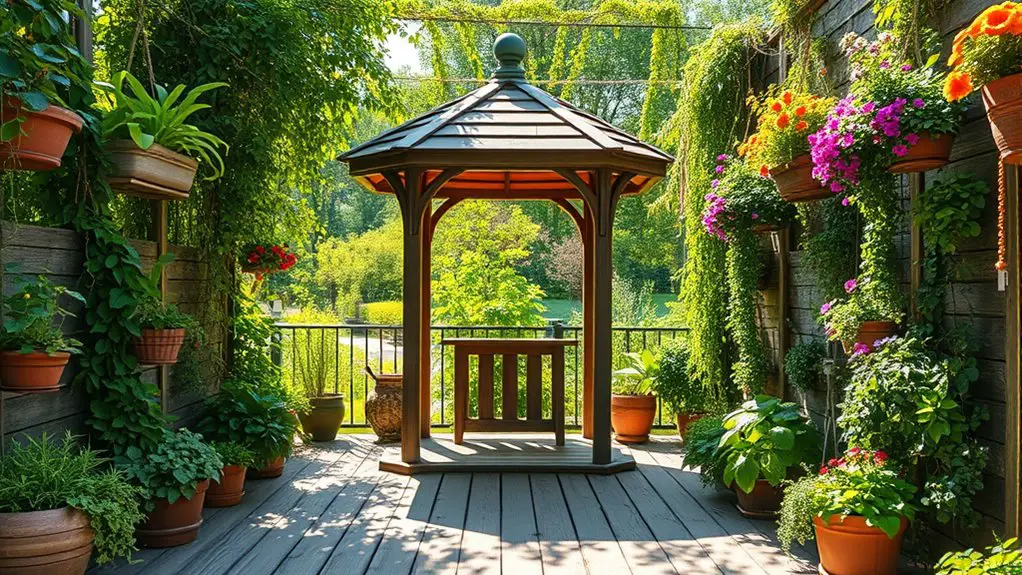To create vertical gardens around your small gazebo, start by choosing a sunny location with good soil drainage. Select climbers like sweet peas or climbing roses for vibrancy and fragrance. Wall-mounted planters and space-saving designs can optimize your vertical space. Regular maintenance, including trimming and feeding, is essential for healthy growth. Incorporating decorative lighting enhances the atmosphere, making the space inviting. There’s more to explore about plant varieties and design integration for a thriving garden oasis.
Choosing the Right Location for Your Vertical Garden
When you’re planning a vertical garden for your small gazebo, it’s vital to take into account the location carefully, as it can greatly impact plant health and growth. First, assess sunlight exposure; most plants thrive in 6-8 hours of direct sunlight daily. If your gazebo is shaded, consider how this could limit your options. Next, evaluate soil drainage—good drainage is important to prevent root rot. If your gazebo sits on a surface that retains water, you might need to install a drainage system or use raised planters to make certain excess moisture can escape.
Moreover, think about accessibility. You’ll want to reach your plants easily for maintenance while making sure they’re not too exposed to harsh conditions. By strategically choosing your location, you’ll cultivate a flourishing vertical garden that not only enhances your gazebo’s aesthetic but also provides a sense of freedom and connection to nature.
Selecting Suitable Plants for Vertical Gardening
When selecting plants for your vertical garden, you’ll want to prioritize climbers and vining species that can effectively utilize vertical space. Consider incorporating a variety of colors and textures to create visual interest and depth. The right combination will not only enhance the aesthetic appeal but also contribute to a thriving green environment.
Climbers and Vining Plants
Although selecting the right climbers and vining plants for vertical gardening can seem intimidating, it’s essential for maximizing space and enhancing the aesthetic appeal of your small gazebo. Consider integrating climbing roses; their lush blooms not only add color but also create a romantic ambiance. Sweet peas, on the other hand, are perfect for bringing a delightful fragrance to your vertical garden. They climb effortlessly and can be trained along trellises or wire grids. When choosing plants, think about their growth habits, sunlight needs, and how they’ll interact with your gazebo’s structure. By selecting the right climbers and vining plants, you’ll transform your gazebo into a vibrant, inviting retreat that feels like an extension of your personal freedom.
Color and Texture Variety
Creating a visually stunning vertical garden in your small gazebo hinges on the careful selection of plants that offer an enchanting mix of color and texture. To achieve mesmerizing color combinations, consider pairing vibrant flowers like petunias and geraniums with lush greenery such as ferns or ivy. This not only enhances visual interest but also provides depth to your arrangement. Texture contrasts play an essential role, too; combining smooth leaves with spiky or fuzzy foliage can create a dynamic effect. Don’t shy away from incorporating different plant sizes to further enrich the garden’s appearance. By thoughtfully selecting plants for their colors and textures, you’ll create a vibrant sanctuary that invites freedom and creativity, transforming your gazebo into a breathtaking retreat.
Exploring Different Vertical Garden Structures
When considering vertical garden structures, you’ll find wall-mounted planters and trellis designs to be essential options. Each provides unique advantages in maximizing space and supporting plant growth. Understanding how to effectively utilize these structures can greatly enhance the aesthetic and functionality of your small gazebo.
Wall-mounted Planters Options
While exploring wall-mounted planters for your small gazebo, you’ll discover a variety of structures that can transform vertical spaces into lush, green displays. Consider self-watering systems; they not only reduce maintenance but also guarantee your plants thrive without constant attention. Look for space-saving designs that maximize your wall area, allowing you to fit more greenery without overcrowding. Vertical pocket planters are a popular choice, offering flexibility and easy access to herbs or flowers. Additionally, modular wall planters can be rearranged to suit your aesthetic, enabling you to express your creativity freely. By selecting the right wall-mounted options, you’ll create an enchanting atmosphere that enhances your gazebo’s charm and functionality, all while embracing the beauty of vertical gardening.
Trellis Designs for Support
Trellis designs play an essential role in supporting vertical gardens, as they not only provide structural integrity but also enhance the aesthetic appeal of your small gazebo. To choose the perfect trellis for your space, consider these elements:
- Trellis Materials: Wood, metal, or PVC can impact durability and style. Choose based on your garden’s needs.
- Trellis Shapes: From classic lattice to modern geometric designs, the shape can influence how plants grow and intertwine.
- Installation Techniques: Securely anchoring your trellis is vital for supporting heavier plants and ensuring longevity.
Designing Your Vertical Garden Layout
Designing a vertical garden layout for your small gazebo can transform an ordinary space into a lush retreat. Start by considering your plant selection; choose a mix of foliage and flowering plants that thrive in your climate. Pay close attention to plant spacing to guarantee each species receives adequate light and air circulation. A common mistake is overcrowding, which can lead to poor growth and disease.
Next, think about your irrigation solutions. Drip irrigation systems can save water and deliver it directly to the roots, promoting healthy growth. Position your plants based on their water requirements; group those with similar needs to streamline the watering process.
Finally, visualize the arrangement from different angles to ensure it’s both functional and aesthetically pleasing. By taking these steps, you’ll not only maximize your vertical space but also create a vibrant vertical garden that enhances your gazebo experience.
Maintenance Tips for Thriving Vertical Gardens
To guarantee your vertical garden thrives, regular maintenance is essential for keeping plants healthy and vibrant. Implementing effective watering techniques and pruning strategies can elevate your garden’s beauty and longevity. Consider these three essential tips:
- Watering Techniques: Utilize a drip irrigation system to guarantee your plants receive consistent moisture, minimizing water waste and preventing root rot.
- Pruning Strategies: Regularly trim back overgrown plants to encourage healthy growth and airflow. This practice prevents diseases and allows your garden to maintain its shape.
- Nutrient Management: Feed your plants with organic fertilizers every few weeks, tailoring nutrients to specific plant needs for peak growth.
Incorporating Decorative Elements Into Your Garden
After ensuring your vertical garden is thriving through proper maintenance, you can elevate its appeal by incorporating decorative elements that enhance both aesthetics and functionality. Start by selecting decorative stones that complement your plants; they can create pathways or borders, adding texture and contrast. Choose a variety of sizes and colors to establish visual interest while maintaining harmony with the natural surroundings.
Next, consider adding garden sculptures. These pieces can serve as focal points, drawing the eye and sparking conversation. Opt for materials like stone or metal that withstand outdoor elements and resonate with your garden’s theme.
Enhancing Your Gazebo’s Ambiance With Lighting
While you may have already curated a stunning vertical garden, enhancing your gazebo’s ambiance with thoughtful lighting can transform the space into a cozy retreat. To achieve effective mood enhancement, consider these key lighting strategies:
Enhancing your gazebo’s ambiance with thoughtful lighting can create a cozy retreat, elevating your vertical garden experience.
- String Lights: Drape warm, soft string lights around your gazebo for a whimsical touch, creating a comforting atmosphere.
- Lanterns: Use decorative lanterns on tables or hanging from beams to provide focused ambient lighting that invites relaxation.
- Spotlights on Plants: Illuminate your vertical garden with spotlights, highlighting the lush greenery and adding depth to the overall design. Additionally, incorporating energy-efficient designs can help reduce electricity costs while enhancing the beauty of your outdoor space.
Frequently Asked Questions
How Much Sunlight Do Vertical Gardens Need?
Vertical gardens typically need 4-6 hours of sunlight daily, though specific sunlight requirements vary by plant selection. Choose shade-tolerant species if your space is limited, ensuring a vibrant, thriving garden that reflects your unique style.
Can I Use Recycled Materials for Vertical Garden Structures?
Absolutely, you can use recycled materials for vertical garden structures. Incorporating recycled planters is a great way to practice sustainable gardening, allowing you to express your creativity while minimizing environmental impact. Your garden can thrive sustainably!
What Are the Best Irrigation Methods for Vertical Gardens?
You might think irrigation’s complicated, but it’s not. Drip irrigation and soaker hoses provide efficient, targeted watering for your vertical gardens, conserving water while promoting healthy growth. Embrace these methods and enjoy gardening freedom!
How Do I Prevent Pests in My Vertical Garden?
To prevent pests in your vertical garden, consider using natural pest deterrents like neem oil and practicing companion planting. This creates a balanced ecosystem, allowing you to enjoy your garden freely while minimizing pest issues effectively.
Are There Any Specific Fertilizers for Vertical Gardens?
For vertical gardens, you’ll want specific fertilizers that guarantee nutrient balance. Organic options like compost tea or worm castings not only enrich your plants but also promote a healthy ecosystem, giving you the freedom to grow thriving greenery.

